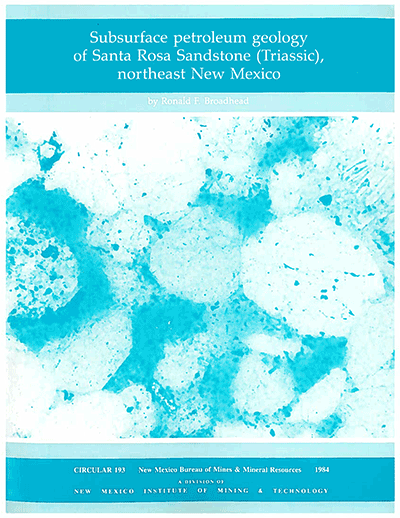
Circular 193—Subsurface petroleum geology of Santa Rosa Sandstone (Triassice), northeast New Mexico
By R. F. Broadhead, 1984, 22 pp., 3 tables, 14 figs.

The Santa Rosa Sandstone occurs at depths of less than 2,000 ft over most of northeast New Mexico. The tar-sand deposit at Santa Rosa Lake is a classic example of an oil seep that indicates the possible presence of commercial oil accumulations in the shallow subsurface. The purpose of this report was to investigate the regional subsurface stratigraphy and structure of the Santa Rosa Sandstone with emphasis on the relationship of stratigraphy and petrography to the regional development of petroleum reservoirs. Although the Santa Rosa Sandstone is currently not producing, two major petroleum accumulations are known to exist in it. One accumulation is located approximately 6 mi north of Santa Rosa, where oil-impregnated Santa Rosa Sandstone crops out; these outcrops of oil-impregnated sandstone are known as the Santa Rosa tar sands. The oil in the tar sands is viscous and heavy. The Santa Rosa tar sands were mined in the 1930s for road-surfacing materials, but presently are not being worked. The other known petroleum accumulation in the Santa Rosa Sandstone is a pool of heavy oil that occurs at depths of 400–800 ft in northeast Guadalupe County.
Attempts are being made to recover the heavy oil with stream-flooding in
two small pilot fields, the O'Connell Ranch field and the T-4 Ranch field.
In northeast New Mexico the Santa Rosa Sandstone is 67–350 ft thick.
It rests on the Artesia Group (Permian) with angular unconformity and is
subdivided into three regionally recognizable units: a lower sandstone unit
18–140 ft thick, a middle mudstone unit 0–144 ft thick, and an upper
sandstone unit 7–150 ft thick. The lower and upper sandstone units
are blanket deposits composed mostly of fine- to medium-grained porous sandstones
and minor red siliciclastic mudstones. The middle mudstone unit is a blanket
deposit composed chiefly of red siliciclastic mudstones and minor lenticular
sandstones. The lower and upper sandstone units were deposited by braided
streams that flowed southeast toward a large Santa Rosa-age lake that was
centered in west-central Texas. The middle mudstone unit is of lacustrine
origin and was deposited during a high stand of the lake. Structures on
the Santa Rosa Sandstone are mostly gentle northwest- to northeast-trending
folds. The heavy oil in the tar-sand deposit at Santa Rosa Lake and the
heavy oil near Newkirk both occur in the upper sandstone unit. Shows of
asphaltic hydrocarbons have been encountered in the lower unit. Stratigraphic
and petrographic studies indicate that good reservoirs are widespread in
the lower and upper sandstone units in northeast New Mexico. The blanket
geometry of the lower and upper sandstone units indicates that structure
probably plays and important role or even dominant role in the trapping
of any undiscovered hydrocarbons in the Santa Rosa. Oil proximal to the
outcrop belt of the Santa Rosa Sandstone has probably been flushed by recently
recharged, fresh ground water. Although the source of the oil in Santa Rosa
Sandstone is definitely not known, geochemical studies point to the San
Andres Formation (Permian) or possible Pennsylvanian rocks.
$11.00
Buy
Now
Also available as a free download.
Download
| File Name | Size | Last Modified |
|---|---|---|
| Circular-193.pdf | 14.86 MB | 01/11/2021 03:43:36 PM |



